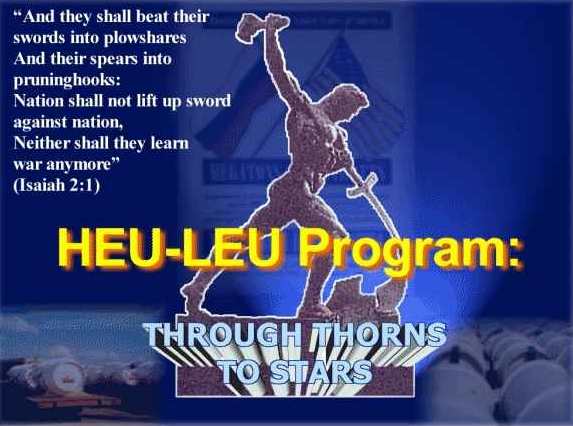

"We have been in hurry while signing these agreement and contracts; unsurprisingly, we have lost sight of one small detail". This sentence of Vladimir Rybachenkov from Russian MFA could be used as an epigraph for any analysis of HEU-LEU deal. All the documents were prepared in hasty manner, and the "young ministry" - by definition of Victor Mikhailov - has no experience in such big intergovernmental business.
As the captious legal analysis shows, the HEU-LEU deal is really different from most of international agreements been signed by the Russian Federation. The HEU-LEU deal architecture has three levels.
The level #1 is the very HEU-LEU agreement, which is obeys the law of international agreements. The level #2 is the level of contracts between the Russian governmental agent Techsnabexport (TENEX) and the foreign juridical persons, and their relationships shall follow the rules of the United States, Sweden and some other countries. Finally, one can see the level #3, where the USEC corporation and other Western companies play the mediatorial role between the Russian nuclear industry and the world uranium consumers.
Three-level architecture in HEU-LEU deal.
Level #1.
Government of Russia and government of USA - the very HEU-LEU agreement.
Rosatom (Minatom) and Department of Energy (USA) - agreements for transparency and removal of feed component to Russia.
Level #2.
TENEX and USEC - agents of Russian and U.S. governments acting in accordance to HEU-LEU contract dated April 14, 1994.
State company TENEX is the Rosatom's agent. Private corporation USEC has the business agreement with U.S. government.
Level #3.
TENEX and companies ConverDyn, USEC, TLI - agreements for delivery and transportation of feed component.
TENEX and Western power companies - contracts for selling of feed component.
What does the three-level architecture mean in practice?
In short, the three-level architecture makes impossible for Russia to adjust the HEU-LEU deal in accordance to its national interests or cancel it if failed to uphold the Russian interests.
One shall note that neither HEU-LEU agreement nor the Vancouver Principles do not consider the three-level architecture. Opposite, from the very beginning the United States promised Russia to follow the equal and nondiscriminatory approach. In particular, Washington guaranteed that the contract would be implemented by the U.S. governmental company, and the agreement will have priority over any contracts.
The three-level architecture was build gradually and methodically - mainly by the United States but with some assistance of Russia. The first step was the modification of the ninth Vancouver Principle and the split of deal into SWU selling and feed component selling as well as the creation of the uncertainty for the feed component payment.
In 1996, the United States issued the USEC Privatization Act. The governmental company USEC was transferred into the private hands. Since then, the U.S. government has no responsibility for USEC operation including the delay in payment for the feed component and non-market selling of the LEU-from-HEU.
From January 1, 1997, the USEC refused to buy the Russian LEU as an entire commodity and restricted its interests to the SWU trade only. In order to compensate the feed component, the USEC began to transfer to the Russian property at the U.S. land the equivalent amount of the natural uranium. Certainly, all the troubles for its selling are now belonged to the Russian side, and one must not forget that the price of feed component is equal to 30-40% of total HEU-LEU deal price.
The buyers for the feed components were found very soon - so called "Western companies", or Cameco (Canada), Gogema (France) and RWE Nukem (Germany), and the mediator companies like the infamous GNSS company. None of them is the U.S. governmental agent, because no private capital was mentioned in the HEU-LEU agreement.
The U.S. government can not interfere in the business activity of the private buyers of the feed component. No money for HEU-LEU agreement were allocated in the U.S. federal budget except one case when the USA paid 325 million dollars in 1998 for 11 thousand metric tons of the feed component accumulated in the USEC warehouses till 1997.
As a result, the three-level architecture gives the possibility to the U.S. government for double-standard relations with Russia. If any dispute arises, the federal U.S. bodies declare its non-interference into the private business activity. Therefore, the Russian government has to deal directly to the USEC and the Western companies with the predictable result - pacta sunt servanda.
The private companies - especially non-U.S. ones - do not interested in the geopolitics. They as the buyers of the feed component think about their business profit, and any Russian attempt to cancel, suspend or modify the HEU-LEU agreement will meet the fierce resistance on the levels #2 and #3.
Summarizing all the facts, one can say that the United States assembled such complicated three-level architecture of the HEU-LEU deal in order to keep the Russian Federation in the borders of the deal till the date of its expiration (2013). It is difficult to say if Moscow will have any space for maneuvering and constructive dialog with the U.S. government for the future of the uranium supply. On may conclude, however, that any harsh action of the Russian side - e.g., the cancellation of the agreement - may turn to multibillion losses for Moscow.
What exactly will threaten Russia if she will try to leave or suspend the HEU-LEU agreement?
To be continued
SOURCE: AtomInfo.Ru
DATE: May 22, 2007